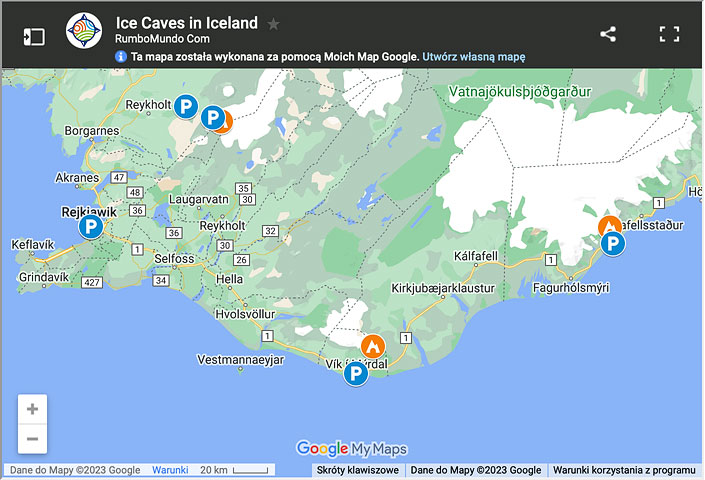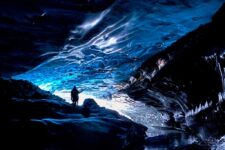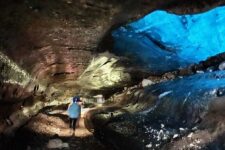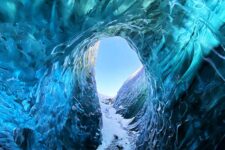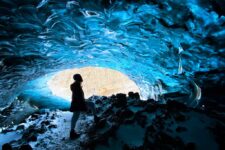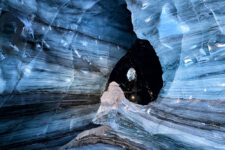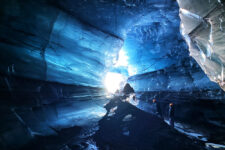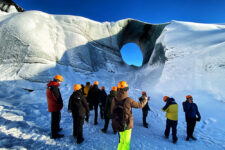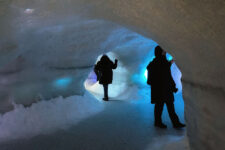Ice caves (or glacial caves) are some of the most beautiful, mesmerising and unique places you can visit in Iceland. What are they, where can you see them, do you have to go in winter, how much does it cost and can you do it on your own – all this (and more) in our complete guide below.
What are the ice caves
S
trictly speaking the term “ice cave” describes two somewhat distinctive formations. One is a rock cave where ice can be found year-round (so “a cave with ice in it”). And the other one is a cave that is formed entirely of ice, inside a glacier (“a cave made of ice”).
To avoid confusion in some places around the world the latter is called a glacial cave, instead. In Iceland, however, no one uses that term. Rock caves are just called caves (or lava tubes, as that’s what they often are) and caves made of ice, are called ice caves.
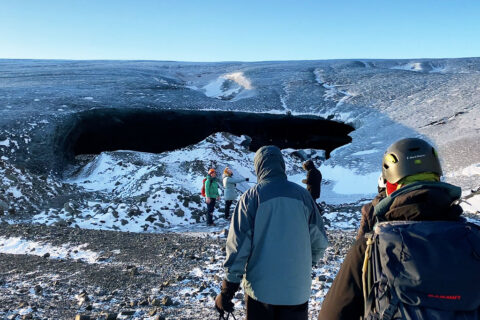
Ice cave entrance at Jokulsarlon
However, the voids that we can call caves, especially those that we can fairly easily and safely visit, are formed by glacial rivers.
As you’ll imagine in summer the top part of the glacier melts quite intensely. This can be clearly seen by the surge of glacial rivers flowing at the foot of each glacier. The streams in Thorsmork, on the F910 road or the ford in front of the Landmannalaugar campground become broader, deeper, run much faster and are often impassable even for the largest off-road vehicles.
But higher up, at glacier level, the water that feeds such surging streams flows inside the glacier, often on the rock at its floor. This way it drills tunnels on the floor of the glacier tongue. And in winter, when the glacier freezes again and the streams disappear, such tunnels are left empty and become beautiful ice caves.
Where are the ice caves in Iceland
Glaciers cover a very large part of Iceland’s surface, and we can drive up to glacial tongues in very many places, all year round. However, the ice caves accessible to tourists are only found in a few selected places in the South Coast.
Map: Location of the main ice caves in Iceland
Ice caves in Iceland: a comparison
|
|
Crystal Cave
(Jokulsarlon) |
Katla Ice Cave |
Langjokull |
Grotto in Perlan |
| description |
ice cave with translucent ceiling |
natural cave inside a glacier |
man-made tunnel in a glacier |
artificial exposition |
| location |
northern shores of Jokulsarlon lagoon |
southern slopes of Katla, NE of Vik |
between Thingvellir and Husafell |
center of Reykjavik |
GPS coordinates
(approx.) |
64.1273
-16.2182 |
63.5470
-18.8196 |
64.6293
-20.4897 |
64.1293
-21.9190 |
| tour start location* |
Jokulsarlon |
Vik |
Husafell |
Perlan |
| tour length |
2-3 h |
3-4 h |
3-4 h |
2-3 h |
cost
(adult person) |
$160 |
$180 |
$180 |
$35 |
| recommended tours |
-> f. Jokulsarlon
-> from Reykjavik (3 days) |
-> from Vik
-> from Reykjavik |
-> from Husafell
-> from Reykjavik |
Perlan – Wonders of Iceland |
| recommendation |
must see |
top choice in summer;
OK in winter |
not a priority |
great for kids |
*all tours may start from Reykjavik as wellIn-depth review of ice caves in Iceland
We’ll discuss the caves in order from east to west, because that’s how their attractiveness is generally arranged. In a way (unfortunately?) it can also be said that the more interesting and attractive a cave is, the farther from Reykjavik it is located….
Jokulsarlon Crystal Cave (the most beautiful one)
Certainly, the most beautiful ice cave in Iceland can be seen near the Jokulsarlon lagoon.
North of the famous lagoon, the Vatnajokull glacier (the largest on the entire island) flows into the valley with one of its tongues – this is Breiðamerkurjökull, or even more precisely: Norðlingalægðarjökull.
The cave in the eastern part of the glacier is particularly attractive. It is the one that is sometimes referred to as the Crystal Ice Cave. And this is where virtually all the truly spectacular photos of Iceland’s ice caves come from.
The exact layout and access to the cave (or caves) changes slightly every year, but in general it remains the same. The glacial tongue flows south here, so it is inclined to the sun, and therefore also heavily lit and flushed throughout the summer. This creates a smooth surface, where the fresh snow on top is relatively easy to melt away, so it doesn’t stop the sunlight from penetrating into the glacier below. Towards the front of the glacier the ceiling of the cave gets thin enough for the sun beams to penetrate it, thus creating the amazing spectacle of light inside.
The walls and ceiling of the cave are fully made of perennial, highly compressed ice. Although the ceiling ice is thick, it is also extremely transparent, and on sunny days it is really bright inside the cave, and flashlights are completely unnecessary (unless you go super deep into the cave).
The
cave ceiling is (usually) at least 1-2 meters thick and so the cave does melt away slowly, but doesn’t collapse. Still, for the risk of some smaller fragments of ice detaching and falling onto your head, everyone’s required (or rather: advised) to wear helmet at all times, when inside the cave. Just to be on the safe side.
The cave is great for exploring also because it’s floor is snow-covered ground and not ice. We are in no danger of falling into a glacial crevasse, or of the ice collapsing underfoot. You can’t really slip neither, because everyone is provided with crampons, when on tour, so there’s no real risk of slipping even if you do step on ice. You just have to be careful not to stumble on the stones and rocks inside.
The trip to this cave takes about 3 hours, and starts at the parking lot at the marina at Jokulsarlon Bay. You get to the vicinity of the cave by a so-called super jeep, which is a small adventure in itself. Tour price includes rental of all the necessary equipment (crampons, helmet, flashlight) and the care of a guide, who will tell you everything there is to know about the glaciers and glacial caves.
The
guides often take groups also to places deep in the glacier, where the sunlight does not reach into and where you actually do need the flashlight. This is a very interesting element of this visit, contrasting sharply with the “palace of lights” in the shallower part of the cave.
Video: Jokulsarlon ice cave from the inside
Unfortunately, this cave is only accessible in winter – generally from November to April – as outside of these months there’s a huge glacial river flowing right through it. But it is certainly the prettiest and most interesting one of all accessible ice caves in Iceland.
Bare in mind the cave loses much of its appeal when it’s not very bright outside. So you have to be a little lucky, not to get there on a heavily overcast day, but also you will do well to book a tour departing near noon, to get as much sunlight into the cave as possible. This is especially important in December and January, when the days in Iceland are extremely short and the sun always stays quite low over the horizon…
As mentioned before, basic tours for this cave start from the parking lot at the Jokulsarlon lagoon and take about 3 hours.
Alternatively, if you prefer not to rent a car, you need to get on a multi-day tour, to see this cave. That’s because Jokulsarlon is almost 400 km (235 miles, exactly) east of Reykjavik and so just driving there and back takes 10 hours minimum (and that’s if the road conditions are favorable).
Multi-day tours are much more expensive, but they don’t only take you to this cave, but also include seeing all there is to see on the way, so along the famous South Coast and even more famous Golden Circle. So a tour like that is actually a package of all the top tours (and locations) combined into one. Plus you don’t have to worry about driving, cooking, accommodation etc. If you’re not planing on renting a car and driving yourself, this is definitely the best option to go for (as opposite to staying in Reykjavik and doing a number of single day tours).
S
imply put: on a multi-day tour you’ll spend a lot more time seeing and enjoying the beauty of Iceland, and much less time just driving to and fro.
Katla ice cave (best in the summer)
The second natural ice cave we can see in Iceland is Katla Ice Cave (isl. Katla íshellir). Similarly to Jokulsarlon, the exact cave you get to visit changes every few years. The guides here tell us that the cave they lead tours to has changed at least four times in the past nine years. Tour operators try to take tourists to the most interesting place currently available, but they are all in the Kötlujökull glacier (part of Mýrdalsjökull), northeast of the town of Vik. On the map above, this is the second from the right and southernmost marker.
Although the caves are often really large, their proximity to Katla means that there are many layers of volcanic ash in their ice. And this, in turn, causes little light to reach the interior of the cave, and so its ceiling is not penetrated by the sunlight. The interior of the cave is really dark and you do need your flashlight even on a sunny day.
Katla ice cave is a beautiful place for sure, but beautiful in a different way than the Jokulsarlon cave. It doesn’t have the spectacular play of lights, but you can see the power and scale of the glacier even better here. While the cave at Jokulsarlon is so beautiful it feels almost unreal, the one at Katla is crude and genuine. Some might even find it sinister. The feeling of being inside the glacier, in it’s very intestines, is much stronger here.
Video: Katla ice cave
Certainly a big advantage of the Katla Ice Cave is that it is available all year round – even in the peak of summer. And that it’s located much closer to Reykjavik. Generally the tours start from Vik, but starting from Reykjavik adds only about 2.5 hours of driving each way, so it’s still fairly manageable.
All the gear necessary for exploring the caves will be provided to you. You only need to dress yourself appropriately, baring in mind that the caves are cold in winter and can be quite wet in summer. Some tour operators will rent you the hiking boots as well as waterproof jacket and pants, if you need those. If you have fear of darkness of claustrophobia, perhaps these tours are not for you. Please review the videos above to make sure you’ll be fine.
Langjökull cave (a tunnel in the glacier)
A “somewhat natural” place that wants to be called an ice cave, although what it really is, is a tunnel excavated inside a glacier exclusively for tourism. So the glacier is perfectly natural, but the tunnel is absolutely artificial.

guided tour inside the Langjökull glacier
Still, the tunnel leads through the interior of a real glacier and shows – to some extent – its real internal structure.
Husafell, from where the tours start, is not much closer to Reykjavik, then Vik is, so there’s no time gain here. The main advantage of this place is that everyone is allowed in – even kids under 6. But then if you travel with such small kids, they will likely have even better time at Perlan (see below), they will learn more there, and you will spend less time and money on that.
L
angjokull tunnel tour is a kind of a bad compromise. No matter what your objectives and constraints are, one of the other tours is better for you. That’s not to say you will not enjoy it – you very well may. But Katla or Perlan should still be better (if you have to choose). And Jokulsarlon ice caves trump them all.
The entrance to the tunnel is at the mountain pass east of the F550 road connecting Thingvellir and Húsafell. You can join the tour at the bottom: in Husafell, at the top: at a place called Klaki Basecamp (accessible only in summer and only in a 4×4 car) or in downtown Reykjavik.
Ice grotto in Perlan
The final cave, this one fully manmade, can be visited in the exhibition center Perlan, downtown Reykjavik.
Perlan is a kind of exhibition and museum center, set to showcase all the ‘faces’ of Iceland. We write more about it here: Perlan: interactively about Iceland.
In Perlan – naturally – there are no real whales, birds or volcanoes, so the glacier here is also artificial. In a sense, it’s just a very large freezer, which is a kind of an educational exhibition. However, it is an interesting exhibition, and compared to other solutions, it is also inexpensive.
If you have a free half day, or the weather doesn’t allow you to move outside Reykjavik, or you are traveling with small children – this is certainly not a bad idea for an interesting tour. Remember, however, that you won’t see such wonders here as in the caves at Jokulsarlon.
Viewing the exhibition (installation?), on the other hand, is completely safe and accessible to everyone, all year round. Plus, you get to see all the other exhibitions of Perlan, which are really worth it. A visit to Perlan is especially valuable at the beginning of your visit to Iceland. It’s a great introduction, and explanation of the processes and history behind all the marvels you’re going to see on your trip.
Visiting Iceland’s ice caves in summer
Most ice caves can be visited in summer. Not the most beautiful cave, in the Jokulsarlon area, unfortunately, but that’s the only exception. The others can be visited all year long.
And since Katla ice cave is “the best of the rest” than that’s certainly the top recommendation for everyone who’s visiting Iceland between May and October. The tour can often also be combined with a 1-2 hour walk on the surface of the glacier, which is also very interesting and, if the weather is favorable, very enjoyable.
And if you’re travelling with children under 6 years of age or people with physical disabilities, then visiting Perlan is your best choice. As described above, the ice grotto there will give you some understanding of what a glacier looks like from the inside, but you’ll also see great many other exhibitions about Iceland’s history and culture.
And if you’re not satisfied with the exhibitions and want to see a bit more of Iceland’s nature, but don’t want to go all the way to Vik or spend the money for ice cave tours, consider the hike to the Glymur waterfall or the extraordinary hot stream in the valley of Reykjadalur. Both places are amazing, 100% natural, free of charge, close to Reykjavik and great ideas for a half-day trip.
If you want to review more of the top attractions in that region, start from this article: Top 10 Things to See on the Iceland Golden Circle Route.
Best ice caves tours in Iceland – which one to choose?
If you are visiting Iceland in winter (generally mid-October to mid-April) and have neither small children (up to 6 years old) nor mobility impaired people with you, then the answer is simple: you should definitely and unequivocally go to the Crystal Cave, at Jokulsarlon. It is certainly the most beautiful cave and a completely unique place. The best time to see it is March, simply because the day is longer then and the sunlight – and therefore all the beautiful luminous effects inside the cave – stronger, especially around noon.
Book your tour here: From Jökulsárlón: a full-day excursion to the crystal ice cave. Unfortunately, these tours are a bit on the expensive side, because you need a place in a super jeep for them, a guide and some equipment, but the experience is absolutely worth it.
If you are in Iceland between spring and autumn – we recommend the caves near Katla, northeast of Vik. The sun doesn’t shine through the cave ceiling as beautifully here, but the sheer enormity of the glacier and the various shapes in the cave itself are certainly interesting and worth seeing. The tours to this cave start from Vik, which is much closer to Reykjavik than Jokulsarlon. Reservations can be made here: Katla Ice Cave from Vik.
For families with small children, a visit to Perlan is the best option. The ice grotto there is one of many interesting exhibits at this educational center. For children a visit to Perlan may be even more interesting, more valuable and certainly less tiring than the nature tours. And it’s equally educational and interesting for adults.
Tickets to Perlan you can buy online: Perlan – Wonders of Iceland.
Visiting ice caves on your own
Iceland is largely a “land of the free”. In that you can do almost anything you want, but don’t expect any state services to come – or fly – to rescue you from your predicament. Especially don’t expect them to do it for free.
So outside the National Parks and private grounds, there is no formal ban on going to glaciers or caves on your own. There are no fines for entering there without a professional guide. But should anything happen to you, you will face the consequences of the accident on your own and on your own expense.
As
an example: a person who broke their leg on the laugavegur trail in the summer of 2023 had to be transported to a hospital in Reykjavik. And just that transport costed them over 2000 EUR, with hospitalisation costs coming on top of that. So despite how expensive the guided tours may seem, going there on your own might prove even more expensive.
Expeditions to most glaciers and entering the caves (especially at Katla) require specialized equipment and a lot of experience. We STRONGLY discourage visiting these places on your own, if you’re not a well-trained professional. Without specialized care, you can even lose your life there.

